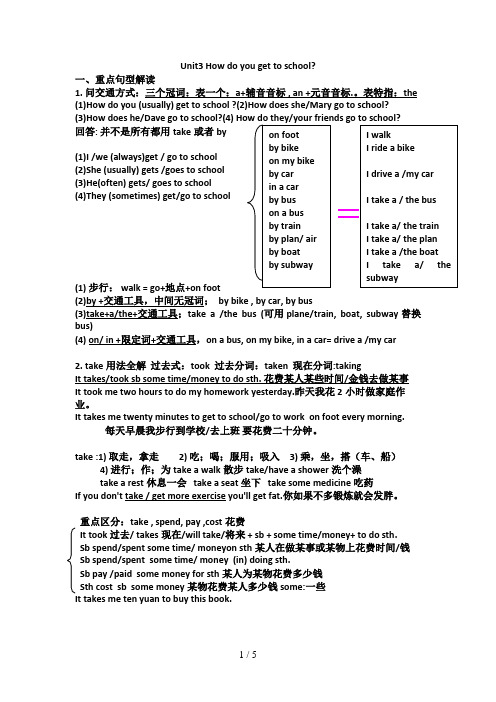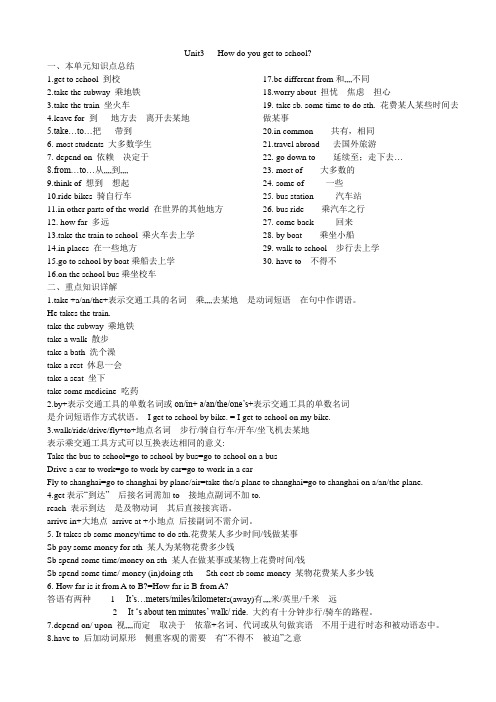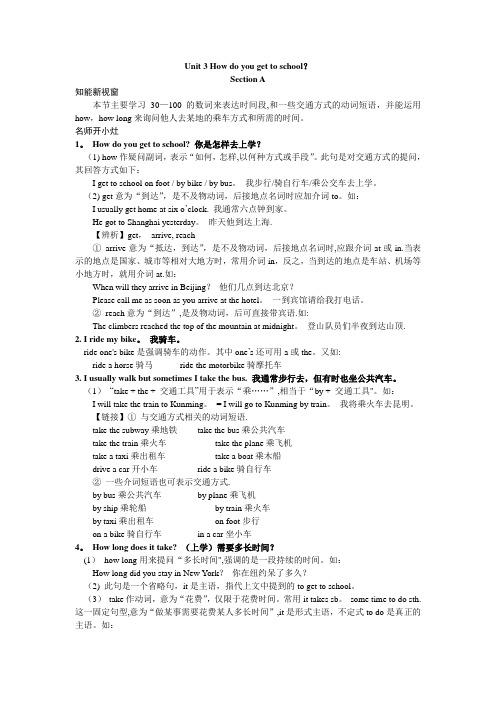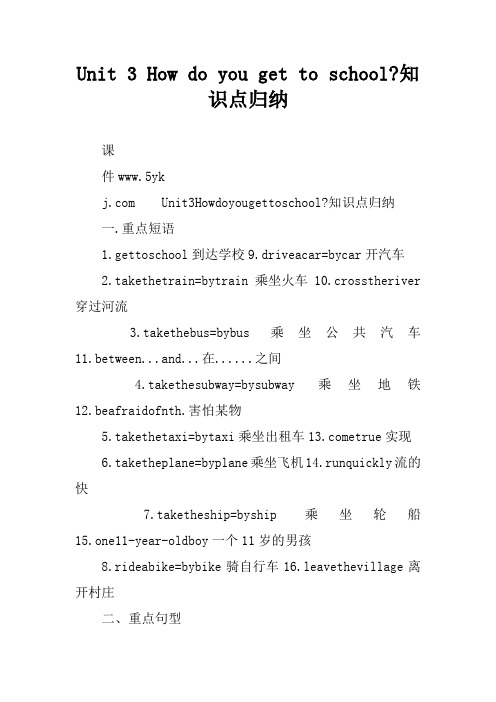unit3howdoyougettoschool知识点
- 格式:doc
- 大小:51.00 KB
- 文档页数:6

Unit3 How do you get to school?一、重点句型解读1. 问交通方式:三个冠词:表一个:a+辅音音标 , an +元音音标.。
表特指:the(1)How do you (usually) get to school ?(2)How does she/Mary go to school?回答: 并不是所有都用take 或者by (1)I /we (always)get / go to school (2)She (usually) gets /goes to school (3)He(often) gets/ goes to school (4)They (sometimes) get/go to school (1) 步行: walk = go+地点+on foot(2)by +交通工具,中间无冠词; by bike , by car, by bus(3)take+a/the+交通工具;take a /the bus (可用plane/train, boat, subway 替换bus)(4) on/ in +限定词+交通工具,on a bus, on my bike, in a car= drive a /my car2. take 用法全解 过去式:took 过去分词:taken 现在分词:takingIt takes/took sb some time/money to do sth. 花费某人某些时间/金钱去做某事 It took me two hours to do my homework yesterday.昨天我花2小时做家庭作业。
It takes me twenty minutes to get to school/go to work on foot every morning.每天早晨我步行到学校/去上班 要花费二十分钟。
take :1) 取走,拿走 2) 吃;喝;服用;吸入 3) 乘,坐,搭(车、船)4) 进行;作;为take a walk 散步take/have a shower 洗个澡take a rest 休息一会 take a seat 坐下 take some medicine 吃药If you don't take / get more exercise you'll get fat.你如果不多锻炼就会发胖。

Unit3 How do you get to school?一、本单元知识点总结1.get to school 到校2.take the subway 乘地铁3.take the train 坐火车4.leave for 到地方去离开去某地5.take…to…把带到6. most students 大多数学生7. depend on 依赖决定于8.from…to…从……到……9.think of 想到想起10.ride bikes 骑自行车11.in other parts of the world 在世界的其他地方12. how far 多远13.take the train to school 乘火车去上学14.in places 在一些地方15.go to school by boat乘船去上学16.on the school bus乘坐校车17.be different from和……不同18.worry about 担忧焦虑担心19. take sb. some time to do sth. 花费某人某些时间去做某事20.in common 共有,相同21.travel abroad 去国外旅游22. go down to延续至;走下去…23. most of大多数的24. some of一些25. bus station汽车站26. bus ride乘汽车之行27. come back回来28. by boat乘坐小船29. walk to school步行去上学30. have to不得不二、重点知识详解1.take +a/an/the+表示交通工具的名词乘……去某地是动词短语在句中作谓语。
He takes the train.take the subway 乘地铁take a walk 散步take a bath 洗个澡take a rest 休息一会take a seat 坐下take some medicine 吃药2.by+表示交通工具的单数名词或on/in+ a/an/the/one’s+表示交通工具的单数名词是介词短语作方式状语。

Unit3 How do you get to school?重点词汇、短语、句型讲解乘坐交通工具表达方式By+交通工具:by bike骑自行车 by bus乘坐公共汽车Take a/the+交通工具:take the train乘坐火车 take the subway 乘坐地铁In/on+限定词+交通工具How do you go to work every day?--I take the subway to work. /I go to work by subway. /I go to work in the subway.其他的表达:ride+限定词+bike/horse骑自行车、马 drive+限定词+car/taxi开小汽车、出租车 on foot步行到达某地的表达方式Get to+地点名词:get to school到学校 get home到家 get here/there到这里/到那里(home/here/there属于地点副词,省略to)Arrive in/at+地点名词,in用于大地方前,at一般用于小地点前面,比如:arrive in China到中国 arrive at a village到一个小村庄Reach+地名,比如:reach home到家里 reach Sydney 到悉尼关于how long/how far/how often/how soon/how many/how much How long译为“多长”,指的是物品(长度),或者指时间(长度)。
当询问时间时,其答语为:About/For+一段时间。
How long does it take to get to school? --About 15 minutes. How long is this ruler? --About 20 centimeters.How far译为“多远”,指的是路程距离的远近。

Unit 3 How do you get to school?Section A知能新视窗本节主要学习30—100的数词来表达时间段,和一些交通方式的动词短语,并能运用how,how long来询问他人去某地的乘车方式和所需的时间。
名师开小灶1。
How do you get to school? 你是怎样去上学?(1) how作疑问副词,表示“如何,怎样,以何种方式或手段”。
此句是对交通方式的提问,其回答方式如下:I get to school on foot / by bike / by bus。
我步行/骑自行车/乘公交车去上学。
(2) get意为“到达”,是不及物动词,后接地点名词时应加介词to。
如:I usually get home at six o’clock. 我通常六点钟到家。
He got to Shanghai yesterday。
昨天他到达上海.【辨析】get,arrive, reach①arrive意为“抵达,到达”,是不及物动词,后接地点名词时,应跟介词at或in.当表示的地点是国家、城市等相对大地方时,常用介词in,反之,当到达的地点是车站、机场等小地方时,就用介词at.如:When will they arrive in Beijing?他们几点到达北京?Please call me as soon as you arrive at the hotel。
一到宾馆请给我打电话。
②reach意为“到达”,是及物动词,后可直接带宾语.如:The climbers reached the top of the mountain at midnight。
登山队员们半夜到达山顶.2. I ride my bike。
我骑车。
ride one's bike是强调骑车的动作。
其中one’s还可用a或the。
又如:ride a horse骑马ride the motorbike骑摩托车3. I usually walk but sometimes I take the bus. 我通常步行去,但有时也坐公共汽车。

Unit3 How do you get to school?一、重点句型解析1. 问交通方式: 三个冠词:表一个:a+辅音音标 , an +元音音标.。
表特指:the(1)How do you (usually) get to school ? (2)How does she/Mary go to school?(3)How does he/Dave go to school?回答: 并不是所有都用take 或者 (1)I /we (always) get / go to school (2)She (usually) gets /goes to school (3)He (often) gets/ goes to school (4)They (sometimes) get/go to school (1) 步行: walk = go+地点+on foot(2)by +交通工具,中间无冠词; by bike , by car, by bus(3) take +a/the+交通工具;take a /the bus (可用plane/train, boat, subway 替换bus)(4) on/ in +限定词+交通工具,on a bus, on my bike, in a car = drive a /my car2. take 用法全解 过去式:took 过去分词:taken 现在分词:takingIt takes/took sb some time/money to do sth. 花费某人某些时间/金钱去做某事It took me two hours to do my homework yesterday.昨天我花2小时做家庭作业。
It takes me twenty minutes to get to school/ go to work on foot every morning.每天早晨我步行 到学校/去上班 要花费二十分钟。

Unit 3 How do you get to school?知识点归纳课件www.5yk Unit3Howdoyougettoschool?知识点归纳一.重点短语1.gettoschool到达学校9.driveacar=bycar开汽车2.takethetrain=bytrain乘坐火车10.crosstheriver 穿过河流3.takethebus=bybus乘坐公共汽车11.between...and...在......之间4.takethesubway=bysubway乘坐地铁12.beafraidofnth.害怕某物5.takethetaxi=bytaxi乘坐出租车etrue实现6.taketheplane=byplane乘坐飞机14.runquickly流的快7.taketheship=byship乘坐轮船15.one11-year-oldboy一个11岁的男孩8.rideabike=bybike骑自行车16.leavethevillage离开村庄二、重点句型1.Howdoyougettoschool?你怎样去上学?2.Howfarisitfromyourhometoschool?你家离学校有多远?3.Howlongdoesittaketogettoschool?到达学校花费多长时间?4.Formanystudent,it’seasytogettoschool.对于许多学生来说,到达学校是很容易的。
5.Thereisaverybigriverbetweentheirschoolandthevilla ge.在学校与村庄之间有一条大河。
6.one11-year-oldboy,Liangliangcrossestherivereveryschoolday.一个11岁的男孩,亮亮,每天穿过河流去上学。
7.cantheirdreamcometrue?他们的梦想能够实现吗?课件www.5yk。
Unit3Howdoyougettoschool?一、本单元知识点总结1.gettoschool到校2.takethesubway乘地铁3.takethetrain坐火车4.leavefor到……地方去,离开去某地5.take…to…把……带到……6.moststudents大多数学生7.from…to…从……到……8.thinkof想到,想起9.ridebikes骑自行车10.inotherpartsoftheworld在世界的其他地方11.howfar多远(路程、距离)12.howlong多长(时间)13.takethetraintoschool乘火车去上学14.inplaces在一些地方15.gotoschoolbyboat乘船去上学16.ontheschoolbus乘坐校车17.bedifferentfrom和……不同18.one11-yearoldboy一个十一岁的男孩二、重点知识详解1.take+a/an/the+表示交通工具的名词,乘……去某地,是动词短语Hetakesthetrain.takethesubway乘地铁takeawalk散步takeashower洗个澡takearest休息一会takeaseat坐下takesomemedicine吃药2.by+表示交通工具的单数名词或on/in+a/an/the/one’s+表示交通工具的单数名词,是介词短语作方式状语。
Igettoschoolbybike.=Igettoschoolonmybike.3.walk/ride/drive/fly+to+地点名词,步行/骑自行车/开车/坐飞机去某地表示乘交通工具方式可以互换表达相同的意义:Takethebustoschool=gotoschoolbybus=gotoschoolonabusDriveacartowork=gotoworkbycar=gotoworkinacarFlytoshanghai=gotoshanghaibyplane/air=takethe/aplanetoshanghai=gotoshanghaiona/an/the plane.4.get表示“到达”,后接名词需加to,接地点副词不加to.reach给示到达,是及物动词,其后直接接宾语。
Unit3 How do you get to school?词组1.get to school 到校2.take the subway 乘地铁3.take the train 坐火车4.leave for 到……地方去,离开去某地5. hundreds of 成百上千6.between…an d …在……和……之间7. .from…to…从……到……9.think of 想到,想起10.ride a bike 骑自行车11.how long 多长12. how far 多远13. come true 实现;成为现实14.many students 许多学生15.an eleven-year-old boy一个十一岁的男孩16.on the school bus乘坐校车17. every day 每天18. cross the river 穿过河18. subway station 地铁站句型1.How do you get to school? I ride my bike .你怎样去学校?我骑自行车。
2.How does she get to school? She usually takes the bus. 她怎样去上学?她通常乘公交车。
3.How long does it take (you) to get to school? 到学校花费你多长时间?It takes about 15 minutes. 大约15分钟。
4.How far is it from your home to school ?从你家到学校有多远?It’s only about two kilometers. 大约只有2千米。
5.Does Jane walk to school?No, she doesn’t. She goes by bike.简步行去上学吗?不,她不。
她骑自行车。
6.I’m not sure.我不确定。
Unit3How do you get to school?一、重要词汇、词组◆subway n.地铁,地下火车◆train n.火车◆minute n.分钟◆kilometer n.公里,千米◆quick adj.快的,迅速的◆half n.一半,二分之一◆past prep.在时间上超过,在......之后,经过◆stop n.车站◆transportation n.运送,运输◆north n.北部,北方adj.北部的,北方的◆depend v.依靠,依赖◆must aux.v.必须,一定要◆bicycle n.自行车◆ill adj.生病的,不健康得◆worry v.担心,担忧,焦虑◆grow up长大,成长◆take sb.some time to do sth.花费某人某些时间去做某事◆in common共有,相同◆leave for离开去某地◆travel abroad去国外旅游◆go down to延续至;走下去…◆most of大多数的◆some of一些◆take the subway乘坐地铁◆how far多远◆bus station汽车站◆bus ride乘汽车之行◆school bus校车◆come back回来◆take the train乘坐火车◆take the bus乘坐公共汽车◆get to school到校◆by boat乘坐小船◆walk to school步行去上学◆from...to...从......到......◆half past six六点半◆depend on依靠,依赖◆be different from和......不同◆have to不得不二、语法知识1.It takes sb.some time to do sth.花费某人某些时间去做某事例如:It took the people a lot of time to get to the mountain.人们花了很多时间才到了那座大山。
一、本单元知识点总结to school 到校the subway 乘地铁the train 坐火车for 到地方去离开去某地…to…把带到6. most students 大多数学生7. depend on 依赖决定于…to…从??到??of 想到想起bikes 骑自行车other parts of the world 在世界的其他地方12. how far 多远the train to school 乘火车去上学places 在一些地方to school by boat乘船去上学the school bus乘坐校车 different from和??不同about 担忧焦虑担心19. take sb. some time to do sth. 花费某人某些时间去做某事common 共有,相同abroad 去国外旅游22. go down to 延续至;走下去…23. most of 大多数的24. some of 一些25. bus station 汽车站26. bus ride 乘汽车之行27. come back 回来28. by boat 乘坐小船29. walk to school 步行去上学30. have to 不得不二、重点知识详解+a/an/the+表示交通工具的名词乘??去某地是动词短语在句中作谓语。
He takes the train.take the subway 乘地铁take a walk 散步take a bath 洗个澡take a rest 休息一会take a seat 坐下take some medicine 吃药+表示交通工具的单数名词或on/in+ a/an/the/one’s+表示交通工具的单数名词是介词短语作方式状语。
I get to school by bike. = I get to school on my bike.ride/drive/fly+to+地点名词步行/骑自行车/开车/坐飞机去某地表示乘交通工具方式可以互换表达相同的意义:Take the bus to school=go to school by bus=go to school on a busDrive a car to work=go to work by car=go to work in a carFly to shanghai=go to shanghai by plane/air=take the/a plane to shanghai=go to shanghai on a/an/the plane.表示“到达”后接名词需加to接地点副词不加to.reach 表示到达是及物动词其后直接接宾语。
arrive in+大地点 arrive at +小地点后接副词不需介词。
5. It takes sb some money/time to do sth.花费某人多少时间/钱做某事Sb pay some money for sth 某人为某物花费多少钱Sb spend some time/money on sth 某人在做某事或某物上花费时间/钱Sb spend some time/ money (in)doing sth Sth cost sb some money 某物花费某人多少钱6. How far is it from A to B?=How far is B from A?答语有两种1It’s…meters/miles/kilometers(away)有??米/英里/千米远2It ‘s about ten minutes’ walk/ ride. 大约有十分钟步行/骑车的路程。
on/ upon 视??而定取决于依靠+名词、代词或从句做宾语不用于进行时态和被动语态中。
to 后加动词原形侧重客观的需要有“不得不被迫”之意有多种时态形式否定式为don’t have to(needn’t)意为“不必”。
Must 侧重于说话者的主观看法认为有必要或有义务做某事只有现在时一种形式,否定式must’t意为“一定不要不允许禁止”反意词为“needn’t”。
number of+名词复数 +复数谓语许多?? the number of +名词复数+单数谓语 ??的数量it rains I take a taxi. 由when, while, since, until, before, after , as soon as, the first time 等引导的时间状语从句中由if, unless 等引导的条件状语从句中主句可以是一般将来时祈使句或有情态动词的句子从句要用一般现在时表将来。
10.感谢用语Thank you very much , Thanks a lot , Many thanks. 回答感谢用语的句子That’s ok /all right. 不用谢。
You are welcome 不客气。
It is my pleasure./My pleasure./It is a pleasure.不客气、那是我的荣幸。
Don’t mention it。
别在意。
It was nothing at all.那没什么。
三、语法归纳一how 引导的特殊疑问句引导的特殊疑问句提问交通方式其答语分三种情况a. take a/an/the+交通工具单数b. by+交通工具单数c. on/in+限定词+交通工具2. how far 用来提问距离多远其答语分为两种1用长度单位表示It is five kilometers.2用时间表示It’s twenty minutes’ walk. long 用来提问时间意为多久回答常用“for+段时”。
----How long have you learnt English? ----For 3 years. how soon 用来提问做完某事还需要多长时间常用于将来时态时常用“in+时间段”来回答。
――How soon will you arrive in Beijing? ----In 3 hours.二宾语从句1.在句子中起宾语作用的句子叫宾语从句。
宾语从句用陈述语序。
2.宾语从句的连接词1从属连词有that, if, whether。
Nobody knew whether she could pass the exam. I know that she is from America.2连接代词有who, whom, whose, what 等 Do you know whose book it is? Could you tell me what your father looks like?3连接副词有when, where, why, how等He didn’t tell me when we could meet again. I don’t know how I can get there.3.时态1主句是一般现在时从句的时态由句子本身确定。
2主句是过去时从句用过去时态。
3主句是过去时从句是客观真理时用一般现在知识讲授1、How do you get to school?(1) how是疑问副词,意为“如何,怎样,用什么手段”。
本句为how引导的特殊疑问句,用以询问交通工具。
① take + a/the + 表示交通工具的名词,是动词短语,在句中作谓语。
② by + 表示交通工具的单数名词或on/in + a/the +表示交通工具的单数名词,是介词短语,作方式状语。
eg: I walk./ I get to school on foot.I ride my bike./ I get to school by bike./ I get to school on my bike.I take the bus./ I get to school by bus./ I get to school on the bus.【注意】by + 表示交通工具的单数名词时,名词前不能加任何冠词或者其他修饰词。
(2)get 在句中为不及物动词,意为“到达”,常与to连用,但是表示目的地的词是副词here、there、home等时,则不需要用介词to。
eg: They’ll get to Beijing at six tonight.I’ll get there on time.2、It takes about 25 minutes to walk.It takes sb sometime to do sth. 做某事花费某人多长时间【辨析】spend, cost, pay 与 take(1)spend 的主语必须是人。
常用于 spend…on sth或 spend…(in) doing sth.意为“某人花时间/金钱做某事”。
eg: I spent 5 dollars on the book.(2)cost的主语只能是事情。
常用于sth cost sb some money意为“某物花费某人多少钱”。
eg: The skirt costs her 200 yuan.(3)pay的主语必须是人。
长用于sb pay some money for sth.意为“某人为某物付款”。
eg: He paid 1000 yuan for the TV set.(4)take用于 It takes sb some time( money) to do sth. 句型中。
eg: It took him seven days to make the big cake.3、Then the early bus takes him to school.take…to…意为“把…带到…”4、(1)意为“环绕;围绕;绕过”eg: The earth moves around the sun.(2)表示“在…四周”eg: There are many trees around the playground.(3)表示“在…的附件”eg: Is there a park around here ?(4)表示“大约”,常与数字连用eg: He goes to school at around 8 o’colck.5、In North America, not all student take the bus to school.not all…这个结构所表达的意思通常是“部分否定”,意为“并不是所有的…都…”。
当not用于代词all, many, much, every, both前时,均属于部分否定。
eg: Not all that glitters is gold. 发光的并不都是金子。